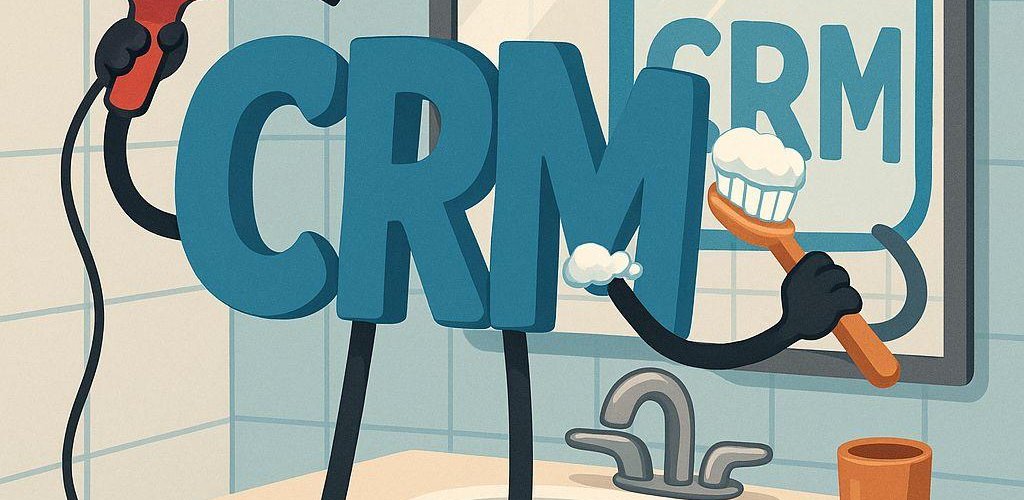Dirty CRM data can cost your business big time – up to $3.1 trillion annually in the U.S. alone. Poor data leads to wasted time, lost revenue, and damaged customer relationships. But keeping your CRM clean doesn’t have to be overwhelming. Here’s how to fix it:
- Set Data Entry Standards: Use clear rules for names, titles, and phone numbers to avoid errors.
- Run Regular Audits: Check for duplicates, outdated records, and missing details every quarter.
- Clean Up Duplicates: Merge similar records and create a single source of truth.
- Enrich Your Data: Add missing info like emails, phone numbers, and key decision-makers.
- Establish Data Rules: Assign team ownership, automate processes, and train staff regularly.
Why it matters: Clean data boosts lead targeting, shortens sales cycles, and improves customer experiences. Start today to avoid wasted time and missed opportunities.
#75 Salesforce Data Hygiene: How to Get It Right – with Janis & Philipp
Why CRM Data Hygiene Matters
Your CRM system is the backbone of your sales operations, but its effectiveness hinges on the accuracy and reliability of the data it holds. Companies that leverage data effectively are 23 times more likely to attract and retain customers. In today’s competitive market, that edge can be the difference between thriving and falling behind. Let’s explore the pitfalls of poor data quality and the rewards of keeping your CRM data clean.
“The harsh truth? Your CRM is only as good as the data it holds. Bad data leads to bad outcomes.” – Sybill.ai
When your CRM data is accurate and well-maintained, it empowers sales reps to focus on high-value leads, choose the right time to follow up, and tailor their outreach.
The result? Faster deal closures and improved conversion rates. And just like keeping a CRM clean ensures smooth sales operations, knowing how to recover a deleted folder can save critical business information when mistakes happen — preventing disruptions and lost opportunities.
Problems Caused by Poor Data Quality
Poor data quality introduces a host of challenges that can undermine your sales efforts:
- Revenue Loss: Bad data can drain resources, costing businesses an average of $15 million annually.
- Data Decay: CRM records degrade over time, with around one-third of data becoming outdated every year. This leaves sales teams chasing dead ends or working with incomplete information.
- Wasted Time: When reps can’t trust their CRM, they spend valuable hours double-checking details, manually updating records, or researching prospects from scratch. This inefficiency eats into time that could be spent selling.
- Missed Opportunities: Unreliable data leads to lost leads – whether it’s due to incorrect contact details or duplicate records. These missed connections can cost your business potential deals.
- Damaged Relationships: Outdated or irrelevant outreach erodes trust. In a world where 80% of people prefer personalized experiences, poor data makes it nearly impossible to deliver the tailored interactions customers expect.
Benefits of Clean CRM Data
On the flip side, maintaining clean CRM data unlocks a range of advantages:
- Better Lead Targeting: With accurate prospect details, sales teams can focus on leads that are most likely to convert. Knowing factors like company size, decision-maker roles, and buying timelines helps reps prioritize effectively.
- Improved Forecasting: Clean data allows for more precise revenue predictions. Right now, only 50% of sales teams rely on data for accurate forecasting, leaving plenty of room for improvement.
- Enhanced Customer Experiences: Accurate data enables personalized interactions, addressing the challenge that 78% of brands face in delivering personalization due to insufficient customer information.
- Increased Efficiency: Organized data streamlines the sales process. Teams spend less time searching for information and more time closing deals. And the financial payoff is clear – every $1 spent on a Sales CRM delivers an average ROI of $8.
The impact of clean CRM data is evident in real-world success stories. For instance, Krish Sivanathan, Director of Operations at Packagecloud, shared how their team achieved an 18% increase in engagement rates:
“Utilizing sales insights we have been able to conduct targeted experiments, enabling Packagecloud to increase engagement rates by 18% through the refinement of scripts and lead targeting.”
This improvement was made possible by having access to clean, actionable data, which empowered their team to target leads more effectively and refine their sales strategies.
In short, CRM data hygiene isn’t just about keeping your database tidy – it’s a cornerstone of sales success. Clean data equips your team to work smarter, connect with prospects more effectively, and create meaningful customer experiences that drive long-term revenue growth.
CRM Data Hygiene Checklist
Now that you see why keeping your CRM data clean is essential, it’s time to dive into the process. This five-step checklist will help your sales team build a solid system for maintaining data accuracy and reliability. As Scratchpad puts it, “Maintaining your CRM’s hygiene isn’t a one-time task but an ongoing commitment.”
Step 1: Set Data Entry Standards
Clean CRM data starts with consistent, standardized data entry. Clear guidelines ensure uniformity and reduce errors. In fact, 92% of analytics and IT decision-makers agree that trustworthy data is more important than ever.
Start by creating formatting rules for all fields. For example:
- Use full names and standardized job titles from professional profiles.
- Record full legal company names.
- Format phone numbers consistently, such as +1 555-555-1234.
Custom fields should include clear examples for dropdowns, tags, and text entries to avoid confusion. Many CRMs, like Teamgate CRM, offer tools to enforce these rules automatically. Use features like validation rules and field restrictions to maintain consistency. Additionally, limit access to sensitive fields to protect your data’s integrity.
Once standards are in place, schedule regular audits to catch issues early.
Step 2: Run Regular Data Audits
Data audits are like routine checkups for your CRM. They help you identify and fix problems before they escalate. Plan quarterly audits to catch duplicates, outdated records, and incomplete entries.
During these audits, focus on common trouble spots, such as:
- Contacts missing key details like email addresses or phone numbers.
- Deals that haven’t been updated recently.
- Company records lacking essential information.
Duplicates are another red flag – look for entries with minor spelling differences or inconsistent formats. Keep track of recurring errors to refine your processes and identify team members who might need additional training. Regular audits ensure your database stays organized and ready for the next step.
Step 3: Clean and Remove Duplicate Data
Duplicate records can wreak havoc on your CRM. They confuse your team, waste time, and can even damage customer relationships by leading to inconsistent communication.
To identify duplicates, watch for:
- Non-standardized names or nicknames.
- Typos in company names.
- Variations in titles, suffixes, or phone number formats.
- Inconsistent website URLs.
Use tools like fuzzy matching to spot similar entries. When duplicates are found, carefully review the information to determine which record is most complete. Merge the best data into one comprehensive profile, creating a “single source of truth” for each contact or company.
Many CRMs offer automated deduplication tools that flag potential duplicates and alert you to new entries that might overlap with existing ones. Set a regular cleaning schedule – whether it’s quarterly, monthly, or bi-weekly – to keep your database in top shape.
Step 4: Add More Data to CRM Records
Good data isn’t just clean – it’s also complete. Enrich your CRM records to give your sales team the insights they need for effective conversations.
Fill in missing details like direct phone numbers, personal email addresses, or active social media profiles. Add company information such as size, industry, revenue, and key decision-makers. Don’t forget important dates, like contract renewals or budget cycles.
Use your CRM’s tagging and segmentation features to organize contacts and companies. Tags can help you track lead sources, product interests, buying stages, and other criteria that make it easier to personalize outreach. Well-structured tags also reveal patterns in your sales data.
Encourage your team to add detailed notes after every interaction. Notes should include what happened, next steps, and any insights for future follow-ups. This context is invaluable when leads change hands or when revisiting old prospects.
Data enrichment tools can also help by automatically updating records with information like company details and social media profiles. These tools save time while improving the quality of your data.
Step 5: Create Data Management Rules
To maintain clean data over time, you need clear rules and accountability. Without them, even the best efforts can fall apart.
Assign ownership of specific data areas to team members. For example, one person might handle contact accuracy, another might oversee company details, and someone else could manage deal data. Clear roles prevent important tasks from being overlooked.
As Jeff Ignacio, Head of GTM Operations and Growth at Regrow Agriculture, explains: “RevOps serves as a single source of truth; it should govern your GTM motion, and your GTM notion needs to impact your revenue. Data-driven insights and decision-making underpin these three notions.”
Train your team regularly on data hygiene practices to reinforce good habits. This is especially important for new hires, who need to align with your standards quickly.
Automate wherever possible to reduce manual work and minimize errors. Set up workflows to validate data at entry, create alerts for incomplete records, and prompt updates for outdated information.
Finally, don’t strive for perfection – it’s an impossible goal. As Sid Kumar, AVP of Revenue Operations at Databricks, points out: “You sometimes have to accept it’s never going to be perfect. There’s no such thing as ‘perfect’ data, and as soon as it becomes perfect, normally it’s outdated and stale.”
Focus on continuous improvement. Even if your data isn’t flawless, consistent effort will pay off with better outcomes for your sales team.
sbb-itb-5772723
How to Track Data Hygiene Success
Once you’ve implemented strong data hygiene practices, the next step is to measure their effect on your sales performance. Start by monitoring key CRM metrics to evaluate improvements in your data. Poor data quality can cost organizations an average of $12.9 million annually, so the stakes are high.
It’s essential to focus on metrics that directly connect data quality to sales outcomes.
Key Metrics to Track
Begin with three fundamental data quality metrics that serve as the backbone of clean CRM data:
- Data completeness: Measures how many required fields are filled in your records.
- Data accuracy: Tracks how often your information aligns with reality.
- Duplication rates: Identifies how many duplicate records exist in your system.
Set clear benchmarks, such as maintaining less than 2% duplicates and achieving over 95% accuracy. These targets provide your team with specific goals and highlight areas needing attention.
Beyond these basics, track metrics that reflect the business impact of clean data. For example:
- Customer churn rate: Shows how many customers leave over a certain period.
- Close rate: Compares the number of deals closed to the leads in your pipeline.
- Customer lifetime value (CLV) and customer acquisition cost (CAC): Help gauge the financial benefits of improved data quality.
Sales efficiency metrics are also critical. Keep an eye on how long leads stay in each pipeline stage and monitor quota attainment to see how close your team gets to meeting sales goals. Additionally, track average resolution time for service tickets to measure whether clean data improves team productivity.
Finally, consider customer satisfaction. A higher Net Promoter Score (NPS) – which measures how likely customers are to recommend your product or service – can often be tied to better data enabling more personalized interactions.
| Metric Category | Key Metrics | Target |
|---|---|---|
| Data Quality | Data completeness, accuracy, duplication rates | >95% complete, <2% duplicates |
| Sales Performance | Close rate, pipeline stage length, quota attainment | Varies by industry |
| Customer Impact | Churn rate, CLV, CAC, NPS | Lower churn, higher CLV |
How to Read Your Data Results
Interpreting your metrics is just as important as tracking them. Raw numbers provide a snapshot, but trends reveal the bigger picture. Analyze how data quality improvements influence sales results, and use these insights to refine your strategies.
Here’s an example of the impact proper analysis can have: A sales team improved pipeline hygiene and saw data completeness jump from 75% to 95%. At the same time, the average opportunity age dropped from 120 days to 90 days, update frequency increased from bi-weekly to weekly, and forecast accuracy rose from 65% to 85%. These changes led to shorter sales cycles, better resource allocation, and more reliable forecasting.
If you notice that data completeness improves but the close rate remains flat, dig deeper. It could mean the additional data isn’t the right kind, or your team might need more training on how to use it effectively.
Teams spend up to 32% of their time fixing data issues, so it’s also worth tracking time-related metrics. Measure how much time your team spends on data cleanup versus revenue-generating activities to identify efficiency gains.
Schedule regular reviews – monthly during normal operations and weekly during intensive cleanup efforts. Use your CRM’s reporting tools to create dashboards that make trends easy to spot. For example, Teamgate CRM offers integrated reporting that displays these metrics clearly.
By calculating the time and money saved through better data quality, you can demonstrate the value of your efforts. This not only justifies ongoing investment in data hygiene but also keeps leadership engaged in the process.
Conclusion
Clean CRM data forms the backbone of efficient sales operations. Did you know that companies lose 12% of their revenue due to inaccurate data? Even more striking, only 3% of businesses meet basic data quality standards. These numbers make it clear: maintaining clean CRM data isn’t just a best practice – it’s a competitive advantage.
This five-step checklist offers straightforward actions to keep your CRM data in top shape. By setting clear data entry standards, conducting regular audits, removing duplicates, enriching records, and establishing strong management rules, you’re not just tidying up your CRM – you’re empowering your sales team to perform at their best.
The results speak volumes. Effective CRM data hygiene can drive a 20% increase in lead conversion rates, cut duplicate contacts by 30%, and boost sales forecast accuracy by 15%. All of this directly impacts your bottom line.
“Data quality is directly linked to the quality of decision making. Good quality data provides better leads, better understanding of customers and better customer relationships. Data quality is a competitive advantage.” – Melody Chien, Senior Director Analyst at Gartner
It’s important to remember that data hygiene is a continuous process, not a one-and-done task. With CRM data deteriorating at a rate of about 34% each year, regular upkeep is essential. Tools like Teamgate CRM can help automate key processes, such as identifying duplicates and validating data, making it easier to maintain high standards without extra manual effort.
FAQs
How can improved CRM data hygiene boost my sales team’s performance?
Maintaining accurate and up-to-date CRM data is a game-changer for your sales team’s performance. When your data is clean, your team can make smarter, more informed decisions, leading to targeted outreach efforts and better conversion rates. For instance, eliminating duplicate entries not only saves time but also boosts overall efficiency.
Focusing on data hygiene delivers real results: higher lead conversions, fewer missed opportunities, and smoother workflows. On the flip side, poor-quality data can lead to lost revenue and wasted resources. Keeping your CRM data current isn’t just a best practice – it’s a critical strategy for driving sales success.
What are the most common mistakes sales teams make when maintaining CRM data hygiene?
Sales teams often struggle with keeping their CRM data clean and accurate, largely due to a few avoidable missteps. One of the biggest culprits is the absence of clear processes for entering data. When there’s no standard way to input information, it can result in inconsistencies, duplicate entries, or incomplete details – turning the CRM into a messy and inefficient tool.
Another common issue is neglecting routine data checks. Over time, outdated or incorrect data builds up, which can lead to missed opportunities and flawed sales plans. On top of that, inadequate training on proper data management practices often leaves team members with bad habits, like inconsistent updates or failing to communicate key details within the team.
The solution? Set up clear rules for how data should be entered, commit to regular audits, and make sure everyone on the team understands why clean CRM data matters. A well-organized CRM isn’t just easier to manage – it boosts productivity, strengthens customer connections, and helps the team make smarter decisions.
How often should I audit my CRM data to keep it accurate and up-to-date?
Keeping your CRM data clean and accurate is essential for smooth operations. Plan quarterly full audits to thoroughly review your data and address any inconsistencies. For day-to-day upkeep, implement weekly spot checks to catch minor errors before they grow into bigger problems. Additionally, schedule monthly reviews to take a closer look at data accuracy. These regular check-ins ensure your sales team has reliable information at their fingertips, helping them work more efficiently and make better decisions.





